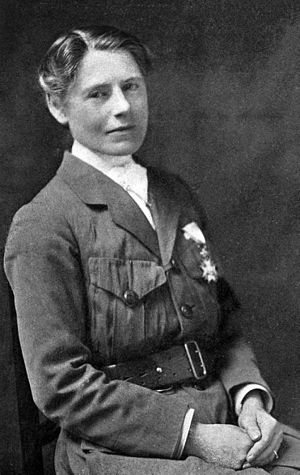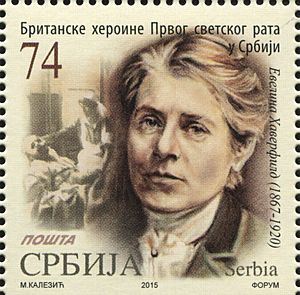Evelina Haverfield facts for kids
Quick facts for kids
Evelina Haverfield
|
|
|---|---|
 |
|
| Born |
Evilena Scarlett
9 August 1867 Kingussie, Scotland, United Kingdom of Great Britain and Ireland
|
| Died | 21 March 1920 (aged 52) Bajina Bašta, Serbia
|
| Nationality | British |
| Occupation | Social activist, suffragette |
| Spouse(s) |
Henry Haverfield
(m. 1887; died 1895)John Balguy
(m. 1899) |
| Parent(s) |
|
| Relatives |
|
Evelina Haverfield (born August 9, 1867 – died March 21, 1920) was a British woman who fought for women's rights and helped people in need. She was a suffragette, which means she believed women should have the right to vote.
In the early 1900s, Evelina joined a group called the Women's Social and Political Union (WSPU). This group, led by Emmeline Pankhurst, worked hard to get women the right to vote. During World War I, Evelina worked as a nurse in Serbia, helping injured soldiers and civilians. After the war, she went back to Serbia with her friend Vera Holme to open an orphanage for children in a town called Bajina Bašta.
Contents
Early Life and Adventures
Evelina was born on August 9, 1867, in Kingussie, Scotland. Her full birth name was Honourable Evilena Scarlett. She was one of six children born to William Frederick Scarlett, who was the 3rd Baron Abinger, and his wife Helen Magruder. Helen's father was a Commodore in the United States Navy.
Evelina spent her childhood between London and the family's estate in Scotland. When she was 13, she went to school in Germany. In 1887, at age 19, she married Major Henry Wykeham Brooke Tunstall Haverfield. He was an officer in the Royal Artillery and was 20 years older than her. They had two sons, John and Brook. Sadly, Henry died eight years later.
Evelina enjoyed a very active lifestyle for a woman of her time. She loved riding her bicycle, which she called Pegasus. Cycling was seen as a way for women to gain freedom and get fresh air. This sense of independence was very important to her.
In 1899, Evelina married another Royal Artillery major, John Henry Balguy. He was an old friend of her first husband. Even after marrying, Evelina soon went back to using the name Haverfield and kept her home. She wrote in her diary that she married Major Balguy with "no intention of changing my name or mode of life in any way."
During the Second Boer War (a conflict in South Africa), Evelina traveled to South Africa for two years. She helped her husband, who was stationed there. She enjoyed being involved in the military area and even practiced shooting rifles. She also set up a camp for horses to rest after their service. After about ten years, Evelina and John separated, but they never officially divorced.
Fighting for Women's Rights
Evelina became very interested in politics and joined groups that supported women's right to vote. In 1909, she helped start a local branch of the National Union of Women's Suffrage Societies. In 1908, she attended a large meeting and began to support the more active suffragettes. She joined the Women's Social and Political Union (WSPU).
Evelina took part in many protests and was arrested several times. In 1909, she joined the "Bill of Rights March." During this protest, members of the WSPU tried to enter the House of Commons, which is part of the British Parliament. Police stopped them, and over 100 women, including Evelina, were arrested.
In 1910, she was arrested again after a WSPU protest. In 1911, Evelina was among 200 women arrested in London. They had broken windows and damaged government buildings during a protest. This was to show their anger about a bill that would have given more men the right to vote, but not women. During this protest, Evelina tried to move police horses to break up the police line.
Around this time, Evelina also became very close friends with fellow suffragette and actress Vera Holme. Their friendship lasted until Evelina's death.
Helping During World War I
When World War I began in 1914, Evelina wanted to help. She thought about how women could assist if the UK was invaded. She then started a group called the Women's Emergency Corps.
In 1915, Evelina volunteered to go abroad with the Scottish Women's Hospitals for Foreign Service. She joined Elsie Inglis in Serbia, where they helped wounded people. In early 1916, they had to leave Serbia because of a German invasion.
Evelina returned to England and told newspapers about the difficult situation in Serbia. Later that year, she traveled to Romania to continue her aid work. With another brave woman named Flora Sandes, Evelina started a fund to help Serbian soldiers and prisoners.
After the War: Helping Serbian Children
After World War I ended, Evelina focused on helping the many children in Serbia who had lost their parents. She traveled back to Serbia with Vera Holme. Together, they helped build a health center for children in Bajina Basta. This center was later named after Evelina.
Evelina Haverfield died on March 21, 1920, at the age of 52, from pneumonia. She is buried in the cemetery in Bajina Basta, Serbia. A special service was held for her in London to remember her amazing work. In 1923, a memorial plaque was placed in a church in England in her honor.
Images for kids
See also
 In Spanish: Evelina Haverfield para niños
In Spanish: Evelina Haverfield para niños



